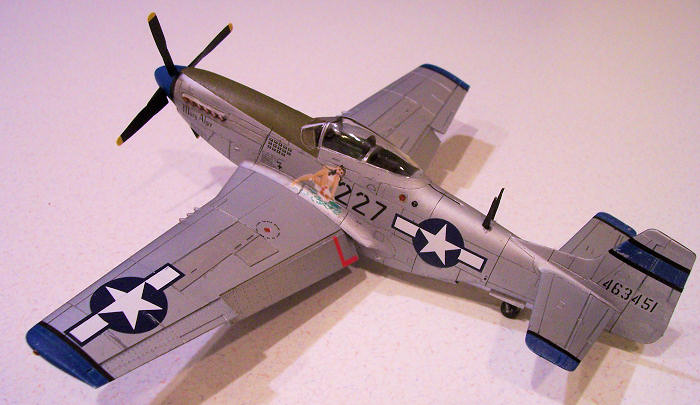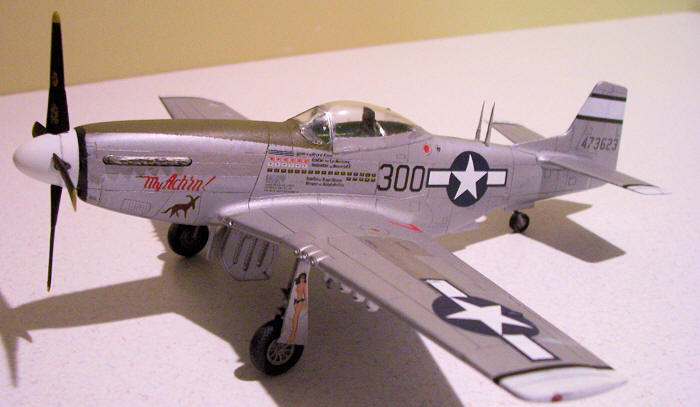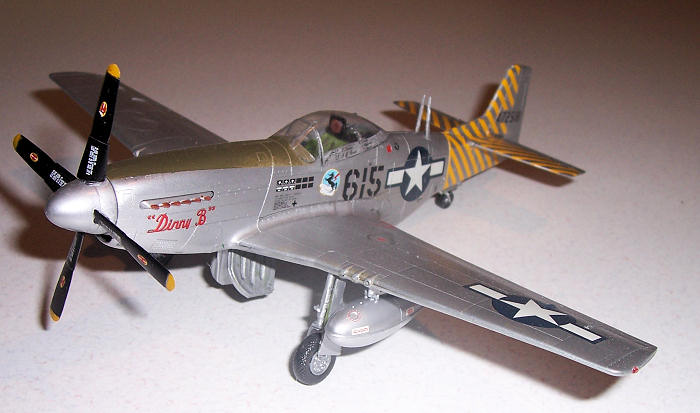
Posted on 01/18/2010 1:41:01 AM PST by myknowledge
The North American P-51 Mustang has been heralded as the best Allied WWII fighter ever and made a significant contribution to the defeat of Nazi Germany and the Luftwaffe.

With over 15,500 of them built, in all variants, this aircraft found its way into the European, CBI and Pacific theaters.




Powered by a Packard-built Rolls Royce Merlin V-1650 V-12 piston engine, drawing ~1700 hp, the P-51 reached speeds of 700 km/h, and with a pair of drop tanks, it had the range to escort bombers from the UK to Berlin and back, from Iwo Jima to the Japanese home islands and back.

Packing six .50 cal Browning M2 machine guns with over 1600 rounds of ammo, the Mustang had enough firepower to rip any enemy fighter into shreds.
http://www.youtube.com/watch?v=ddtqJImF5Qc
I'm sure that you aviation fans know a lot more about the P-51, but I have started this thread because I wanted to ask this question:
What if the P-51 Mustang had not been in WWII?
My response to that is maybe the U.S. 8th AF would have to compensate using P-38s (fork-tailed devils) and probably late mark RAF Spitfires.


This would have meant more bomber casualties and losses from German AAA and Luftwaffe Bf 109s, Fw 190s and Me 262s. More of them could have been airborne due to the aircraft plants not being bombed.

The P-51 sure was pretty though!
Honorable mention needs to go to the much maligned P-39 Airacobra. A strange, stubby little aircraft, with a mid-engine placement, just *behind* the cockpit, designed around its main weapon, a 37 mm (1.46 in, 1.3lb projectile) Oldsmobile T9 cannon, which, when it worked, was devastating.
US and RAF pilots hated it, from the ground up, and considered it a death trap.
It had automobile type side doors, a liquid cooled engine, a cramped cockpit, and a propensity for spinning very flat and tumbling.
Don’t give me a P-39,
With an engine that’s mounted behind,
It will tumble and roll,
And dig a big hole,
Don’t give me a P-39.
— an AAF ballad
The US made some 9,600 of them, of which over half were given to the Soviet Union. The Soviets, however, fell in love with it.
In the close air support, anti-tank role, they thought it was the very best “can opener” ever invented. Soviet pilots started racking up some serious Panzer kills and scored the highest number of individual kills attributed to any U.S. fighter type. And for this reason, many of their subsequent aircraft designs, for a decade or more, featured mid-engine placement.
Aren't all tail draggers?
That might be, but the radial was air cooled, the Merlin liquid. Lose the radiator and you're gonna have a bad day.
Aren't all tail draggers?
That certainly is the case with trying to taxi and the initial roll on TO peeping around that nose that seems to be about 50 foot long!
The P-51D, the definitive Mustang with the bubble canopy and the Merlin engine, didn’t reach Europe until mid-1944 - about the time of the D-Day landings. So obviously Mustangs were not a factor in that planning, it would have gone off as scheduled. Given that, then there is no reason to believe that the ground campaign would have taken much longer than it did so the lack of the Mustang would not, in my opinion, have changed the results of the war or lengthened, to any great extent, the timeline. The strategic bombardment campaign would have been more costly but it would have continued. Germany still surrenders around April or May of 1945.
The real secret to the P-51 was the 100-octane fuel it burned. The Mustang was optimized for an engine using 100-octane. The fuel gave it both its large cruising range and speed and acceleration in battle.
And the guy that got the USA (and UK) using 100-octane? Jimmy Doolittle.
For a look at the impact of 100-octane fuel on WWII read “Jimmy Doolittle and the Hundred Octane War” an article in “World at War Magazine” in 2009.
The P-47 was no slouch. However, if the Mustang were not available, I think the F4U Corsair had the range, speed and maneuverability to do its job. And, with a radial engine, it would be much tougher.

The P51 was particularly vulnerable to ground fire. Any hit on it's underside pretty much would bring it down. It was not used as often as the P47 in ground strikes as a results. The P47 was hands down more rugged than the P51 and the later models had almost the same range as the P51. However, I think we needed both fighters.
As for the P38 it had an icing problem in the cold air in the skies over Europe and usually stayed at low altitudes and was used as a ground strike aircraft in Europe.
In the pacific the P38 was unbeatable, along with the Corsair and the F6F Hellcat.
Personally I am prone to the P47 overall and if you want the actual best fighter of WWII in Europe(of either allied or axis) then I would have to go with the long nosed(as opposed to the short nosed) FW190(the ME262 was too little to late).
I’ve sit in the cockpit of the Corsair, never flew it, but yes they are very similar from that brief experience. I have a couple hundred hours in the U-6 Beaver and a about 50 in the O-1 Birddog and they are a piece of cake compared to the P-51. Of course both of them are flying speed brakes!
I have pictures of taxing P-51s with groundcrewmen riding on their wings. They gave directions to the pilots, who couldn’t see past the very long nose of the Mustang, then hopped off when the fighter turned on to the runway.
Years ago I flew into State College Pennsylvania. Agter I got out of the plane I heard a noise down at the approach end of the strip. I lokked downthere and saw 2 P51’s in echelon. They roared down the strip at about 100 feet then climbed to the break and landed. I was only feet away. It was about as exciting as it gets. I’ve also been used as an intercept target by F15’s in my T210. That was also awesome but no sound effects!
The ultimate is to stand at the end of the runway in Hamilton, Ontario when the Lancaster is flying. It is like 4 P51’ in close formation.
The fixes to the P-47 & P-38 didn’t really arrive until AFTER they were withdrawn from active escort duties. I imagine that if the P-51 hadn’t been a success that those refinements would have arrived earlier out of necessity.
Not by a long-shot. An air-cooled radial engine is inherently tougher than a liquid-cooled in-line engine with it's vulnerable radiators. The USAF lost a lot of F-51's in Korea pressing attacks against ground targets. If they had fielded the P-47N's that were still in use with the Air Guard they would have had a tougher ground attack plane that would have brought its pilots home.
I've read that the reason that they sent the F-51 instead of the P-47 was due to the availability of parts/airframes (and probably trained pilots already checked out in that type).
Maybe not deliberately, but P-51 flights would often detach from the bomber stream to got hunting ground targets or looking for a Luftwaffe airfield to shoot up. This was how a lot of P-51's met their end as the Packard-Merlin would sieze-up pretty quickly of it lost coolant.
I was waiting for a lab test and in the waiting room was a older couple. He was wearing a 'P-51'ball cap.
I went over and sat by them and struck up a conversation.
Fascinating experience. He was eager to relate war stories and talk about his flying.
When he went into get his labs I talked to his wife.
She said he loved the P-47 more than the P-51 and told her if he could have married one he would have. :)
As far as what we would have done had we not had the P-51, coming up, too late for action was the F8F Bearcat. A mean flying machine.
I'm sure it could have handled any German fighter save the ME-262.
Range may have been a problem though.
There used to be a privately-owned P-51 that was hangered up there at Mid-State Airport when I attended PSU (back in the late ‘70’s). I knew a couple of students who were taking flying lessons out there & they frequently saw it.
I've seen various numbers mentioned, but not a detailed breakdown battle-by-battle, operation-by-operation or theater-by-theater. However, I think we can say the following:
In summary: on the Western Front relative combat superiority depended on circumstances, but more favored the allies as the war progressed.
Another reason why the F-51 was sent to Korea, according to the military brass, was that the Mustang ‘looked sexier’ than the rotund-looking Jug.
Disclaimer: Opinions posted on Free Republic are those of the individual posters and do not necessarily represent the opinion of Free Republic or its management. All materials posted herein are protected by copyright law and the exemption for fair use of copyrighted works.